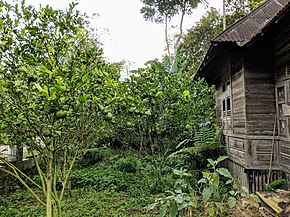
Pekarangan (Indonesian pronunciation: [pə'karaŋan]) is a type of tropical home garden developed in Indonesia, mainly in Java. Pekarangans typically contain plants, while some possess animals (including farmed fish, ruminants, poultry, and wild animals) and structures such as pens and bird cages. The gardens yield food for subsistence and income, and plants for ornamental use. Along with their subsistence and commercial uses, they are used for social interactions and yield sharing and provide materials for cultural ceremonies and religious practices. Some pekarangans are made, maintained, and spatially arranged according to local values. Home gardens of this kind may have existed for several thousand years, but their first mention is found in a Javanese chronicle that was written in 860 AD. In 2010, around 103,000 square kilometers (40,000 sq mi) of Indonesian land were used for gardens of this sort.
The sustainability and social roles of pekarangans have been threatened by mass urbanization and land fragmentation, which are the factors of decreasing land dwelling area on average. The decrease is consequently followed by loss of plant diversity within the gardens. Additionally, some owners deliberately reduce the plant diversity to optimize yields for commercial purposes. Problems such as pest outbreaks and a rise in household debts have appeared due to the degraded sustainability of the gardens.
Throughout the history of Java, pekarangans have been of little interest to the governments that have ruled the island due to their minimal susceptibility to yield extraction. In the 2010s, they have gained the attention of the Indonesian government implemented through P2KP (Percepatan Penganekaragaman Konsumsi Pangan), a program focused on urban and peri-urban areas that aims to optimize production with a sustainable approach.